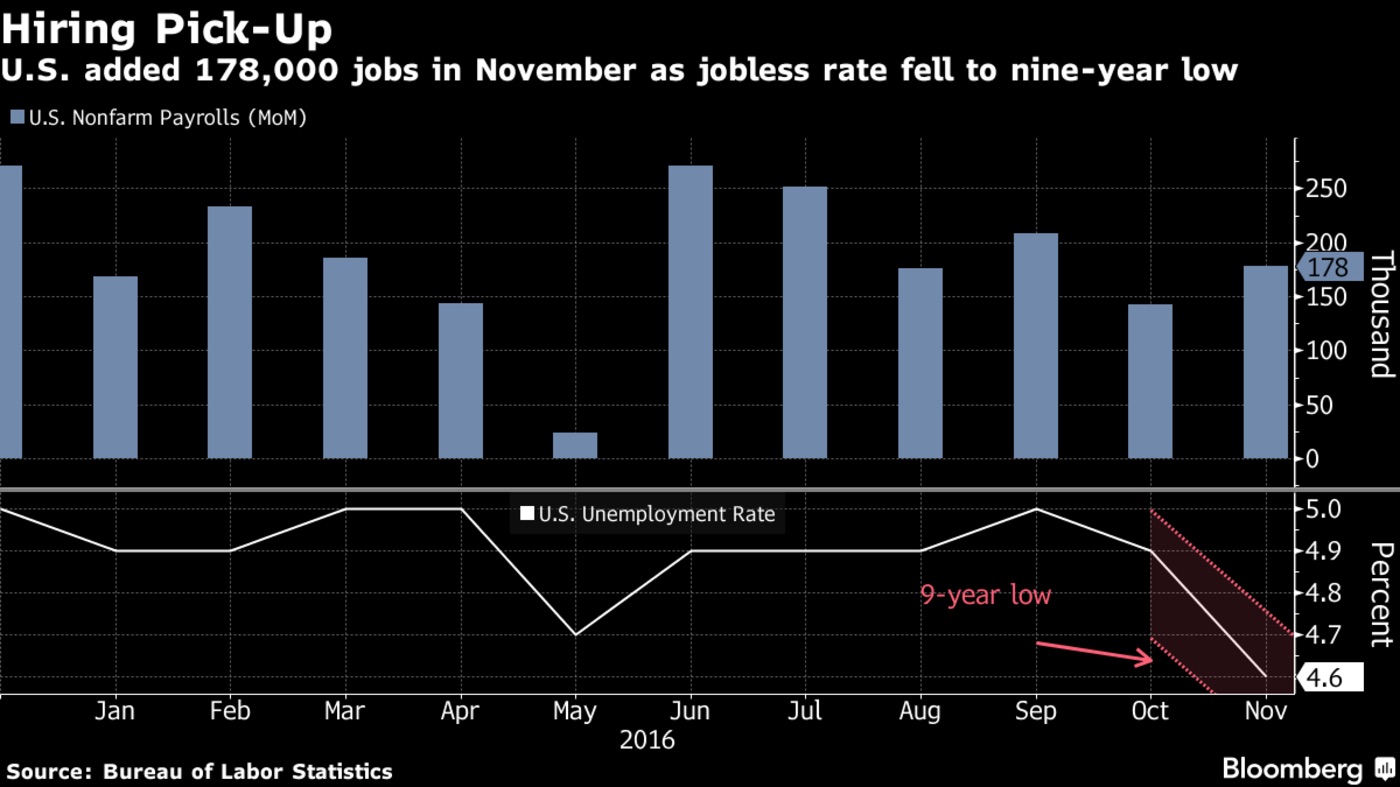Tighter Job Market, Machine Learning & Hiring
Monday, September 25, 2017The American unemployment rate is at a 9-year low. There are similar trends in most Northern European countries. In a lot of industries the job seekers are now calling the shots. This will also likely lead to an increase in wages in the next period, since employers have to pay more to attract and retain workers.
Disclaimer: I currently work on a Machine Learning project for a recruitment agency. The opinions expressed here represent my own and not those of my employer.
 (Bloomberg.com. 2017. America’s Job Market Gets Tighter, as Wage Drop Seen as Blip - Bloomberg. [ONLINE] Available at: https://www.bloomberg.com/news/articles/2016-12-02/america-s-labor-market-gets-tighter-with-wage-drop-seen-as-blip. [Accessed 18 June 2017].)
(Bloomberg.com. 2017. America’s Job Market Gets Tighter, as Wage Drop Seen as Blip - Bloomberg. [ONLINE] Available at: https://www.bloomberg.com/news/articles/2016-12-02/america-s-labor-market-gets-tighter-with-wage-drop-seen-as-blip. [Accessed 18 June 2017].)
For companies, this means a lot of new problems: tougher salary negotiation, fighting off competitors, higher quit rates, etc. In addition, it has to remain competitive in the hiring process as well. How can a company improve this? Machine learning could be part of the answer.
Applying to jobs is a tedious and exhausting process. Unbelievably clunky ‘career’ pages, companies that respond only after weeks of waiting, if they respond at all. I’ve seen lots of instances where companies receive thousands of job applications a month. Often this is all sent to a decade-old applicant tracking system (ATS) in which each and every application is processed manually. This quickly leads to rising costs for the company and longer waiting times for the applicant. Companies simply can’t afford to continue this anymore. Nowadays waiting too long to respond means you run the risk of losing talented candidates to a competitor. By developing sturdy models based on carefully chosen feature sets you can use historical patterns to shift through these applications more easily.
The optimization already starts before the actual application comes in. Lots of companies have a career page or make use of job boards. These are often loosely organized pages. Based on search queries from potential applications, the site should highlight the most relevant openings (low hanging fruit: proximity to the job, seniority level, etc.) and (ideally) give the applicant a good sense of where in the process they are; what are the steps and how long until they can expect a reply. A smarter site should reduce friction for the potential candidate, so more relevant applications will come in.
Then, when the application reaches the database, it’s important that someone looks at it as soon as possible. The Machine Learning model should be able to determine the strength of a certain candidate’s application. This will bring guidance to the recruiter working through this. Is someone unexceptionally qualified? This should trigger an alert requesting a fast(er) response. For candidates labeled as highly uncertain, more relevant vacancies could be suggested, linking them to better opportunities. You shouldn’t make the mistake of only using models to reduce the number of applications you spent time on. Potentially more value lies in identifying talent that a manual process would’ve missed otherwise.
As with everything in Machine Learning, the whole thing depends on the availability of data. Even the largest companies in the world will not be able to utilize these ideas if they don’t track data properly. Some ideas on what you could track and include in your models;
- Data collected during exit interviews; why did someone leave? Where did they leave to? Also, try to combine this with data on this person’s previous performance and feedback.
- Data on hires; make sure you record where a candidate is coming from, how many interviews that person had, and the feedback during the screening process
- Tests; Did the candidate complete any tests and training? What insights did this provide you?
In my opinion, Machine Learning shouldn’t be used to solely replace recruiters or downsize your HR department. It should be seen as a valuable tool that will help your company select better colleagues. It could free up time though, which can be spent doing things that software can’t, like coaching. In addition, it’s important to be aware of bias creeping into your models, especially when you just start out these models need a lot of attention.
What else? I’d be interested to hear how your or your company is utilizing Machine Learning. Drop me an email or connect on Twitter.
-
Coding as a Product Manager
For productivity's sake
-
Tighter Job Market, Machine Learning & Hiring
Essay on the impact of the need for Machine Learning in HR
-
YouTube Picture-in-Picture on iPad
Easily enable PiP-mode on YouTube
-
YoungCapital creates breakthrough in machine learning in recruitment
Press release of one of our projects
-
Essential reading list for product managers
Book recommendations for Product Managers